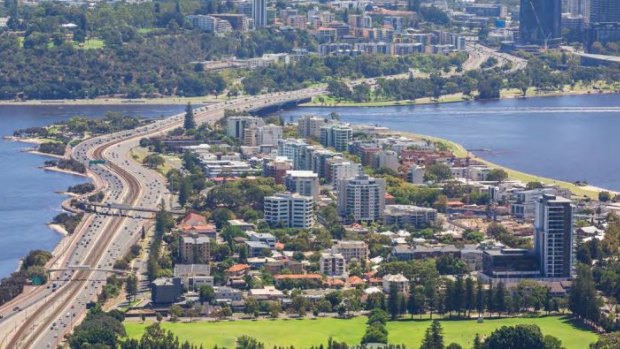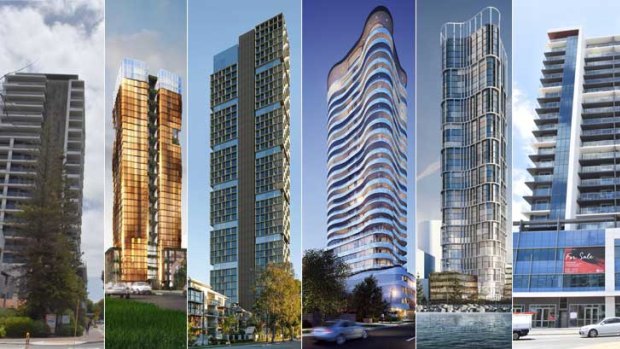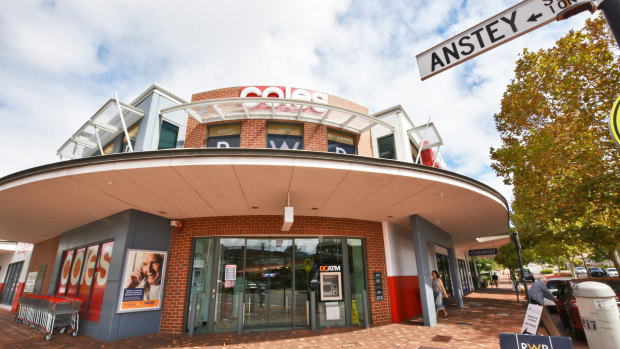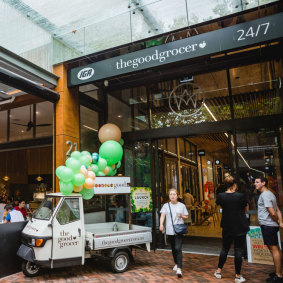This was published 5 years ago
The inner Perth suburb that forces you to drive 15 minutes to your weekly shop
By Emma Young
Even as hundreds of new residents move in to new apartment towers, the disappointment at canned plans for a South Perth supermarket have highlighted that people who already live in the fast-transforming suburb are hyper-reliant on cars for the most basic weekly errands.

South Perth Peninsula is changing rapidly. Credit: Roberts Day
The 100-hectare area stretching from the tip of the South Perth peninsula at the Narrows Bridge, down to Perth Zoo, has seen a huge transformation in the past couple of years.
The council’s rezoned this small area, currently home to 2675 people, to allow its population to almost double by 2031 and almost triple by 2041.
High-rise apartment towers of the size only previously seen in the CBD have been built, with many others proposed or under construction, so an influx of hundreds of new residents is imminent.
The central narrative of the state government’s push for such development in inner suburbs is diversity – allowing for single and low income earners, families, young people and the elderly to mix in suburbs that were formerly enclaves of wealthy baby boomers.
Just the type of people who depend on having practical, affordable shopping options within walking, biking or bus distance from their homes.
The narrative also prominently features hopes that increased density will maximise walkability and help end our costly reliance on cars.

Some of the towers already built or proposed.
But residents told WAtoday they had no single supermarket within a 15-minute drive that combined the quality and affordability required for a one-stop weekly shop.
Asked where they routinely drove to shop, they named Victoria Park, Bentley, Mount Pleasant and even Booragoon and Subiaco.
The only big-brand supermarket in the suburb is a tiny Coles, smaller than the couple of IGAs in the area and with strictly limited stock. Locals call it “congested” and parking on the village-style street a “nightmare”.

The Coles is closer in size to a village market and its limited range, dominated by home brand products, has alienated some shoppers. Credit: Cameron Myles
“Cramped and very busy ... the checkout line for non-self serve checkouts can extend into the produce section making it very difficult to navigate. I would not recommend coming to this Coles if you have a child in tow,” said one Google review.
A recent redevelopment of the Mends Street shopping precinct did not feature a supermarket, just refurbishment of an existing small gourmet grocer.
And Finbar’s planned Civic Heart apartment towers in the Civic Triangle (the focal point for the entire precinct, just by the freeway entry) recently dropped a Woolworths that was originally the headline tenant.
A Woolworths spokesman said the developer’s amended design no longer had space for a supermarket.
The news came as a blow for one South Perth mother who said that for a shop she usually drove 15 minutes to Victoria Park’s Woolworths, and for fresh produce to Bentley’s Spudshed, or Victoria Park’s Swansea Street Markets, both 20 minutes’ drive from home.
“If haven’t got time I am left with the IGAs; there are a couple around, with good variety and fresh produce but they are much more expensive,” she said.
The fruit and veg market near her house was “very gourmet and very expensive ... not for a routine vegie shop.”
She routinely drove to multiple stores to complete her shopping.

There are plenty of small gourmet grocery stores in the area but these can't cater for everyone.
“I have the time and I have the car so I modify my behaviour and I go to five different places but it would be really nice to just have one place to go to,” she said.
“It would be very hard to be catching a bus or riding a bike.
“If you are don’t have a car you are stuck with the local gourmet shops – my elderly neighbour used to go to the IGA in Karawara on the bus.”
Barring some kind of cultural revolution or substantial new local facility, it's hard to come to any conclusion bar that the doubling of the population by 2031 will only double the number of cars on the roads.
It might sound like a first-world problem, but for government authorities trying to spruik the benefits of infill housing, it highlights the difficulties in trying to stimulate corresponding business development (the biggest jobs driver) in residential areas.
And cost of living is the biggest dampener on consumer confidence in WA, with groceries, utilities and transport a concern for almost three out of five respondents to the Chamber of Commerce and Industry’s latest Survey of Consumer Confidence.
And authorities have their hands tied to an extent. It is the chains that weigh the risks and demand in deciding new locations. They frequently face opposition, often centred around parking, access and traffic, and trying to set up shop in already built-up inner city areas is problematic.
Though it is expanding rapidly in WA with 41 stores already and plans to expand to 70 in coming years, Aldi is overwhelmingly locating new stores in outer suburbs where space comes at less of a premium and likely less of a headache.
A Farmer Jack's planned for Canning Highway in neighbouring Como, despite being planned for a large block on the major artery of Canning Highway, has been mired in controversy and unable to secure development approval over the past several years, facing strident opposition revolving around parking and traffic from locals highly protective of amenity.
Another big-box development nearby, Dan Murphy’s on Canning Highway Como, also faced years of strong opposition, though it eventually secured approval with development slated for 2020.
A Coles spokeswoman said Coles would welcome the opportunity to extend the South Perth store and would work with the owners and council to determine what was possible.
Woolworths said, "We know there is strong demand for a modern and convenient supermarket in the community and will keep looking for opportunities to bring one to the area."
If the Farmer Jacks and Dan Murphys experiences are anything to go by, they’ll face an uphill battle.
Maybe by 2031 most of us will do all our shopping online.
If not, those 2000 new residents of South Perth could face a pretty long line at the checkout.